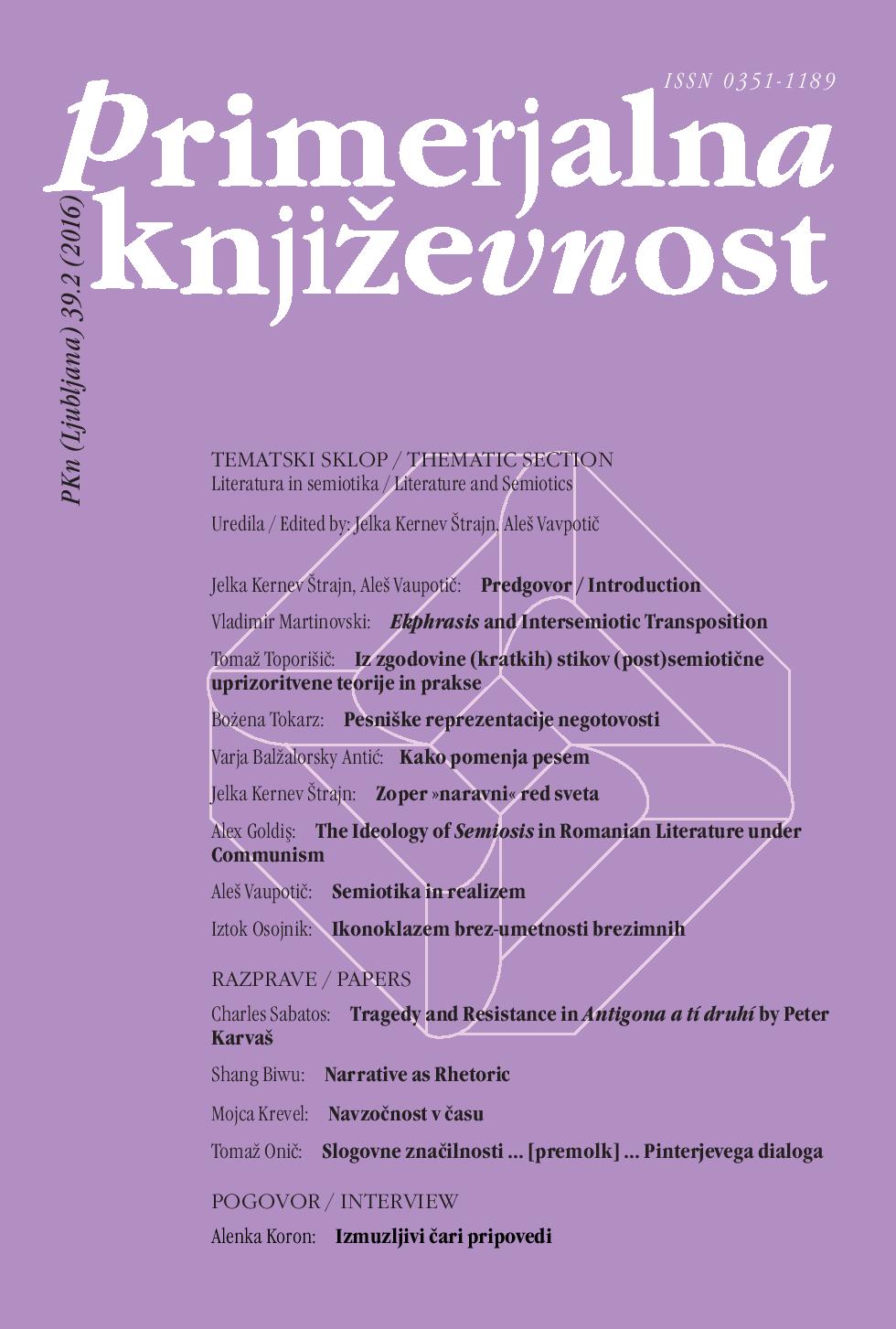Semiotics and Realism
Keywords:
semiotics, Saussure, Ferdinand de, Peirce, Charles Sanders, realism, stoicism, discourse theoryAbstract
De Saussure’s dyadic semiology construes signs as resulting from two parallel measurable masses that are subdivided into corresponding places: one signifier section and one signified section. Any signifier is automatically transformed into its signified in the listener’s mind participating in the speaking community at a given moment. De Saussure chooses to study the system of language over the examination of its manifestations as speech. However, the structuralist semiological tradition is a recent one. In the ancient semiotic models, the sign is a scheme for inferential reasoning; it is based on implication. A continuity between these theories of sign and the contemporary line of cognitive semiotics – as represented by Peirce, for example – is apparent. – In literature, different semiotic models are at work. In the absolute subjectivity of Romanticism, limitless possibilities springing out of an artistic creativity are implied. In the Realist world, a person faces one continuous unyielding field of reality, which requires explanation and threatens to get out of control. What would the Realist poetics be in order to be able to tackle such a reality? A possible approach to the study of Realism is using the theory of discourse, focusing on the multiplicity of voices. Because reality is not self-evident, the phenomena turn into signs that require interpretation. The only possibility left is to start collecting the sign fragments. Here, the sign process avails itself of the archival model, such as in late Realism. The cases of Gustave Flaubert, attempting to write an “encyclopedia of human stupidity”, and the breakdown of the archival aesthetics in Walter Benjamin’s theory of allegory are scrutinized. – In contrast, in the later novels by Charles Dickens, heroes possess a specific power of projection. Heroes are capable of changing the events in the novel; the word adapts to them. In such a case, the worldviews would be considered vectors that help chart the territory of an encyclopedia. Hans Vilmar Geppert proposes such a model of Realist logic, based on Peirce’s triadic semiotics: the sign consisting of the representamen, object, and interpretant. – The article concludes by proposing three strands of further inquiry. The issue of realism in philosophy presupposes independence or the existence of common ideas and objects. The issue of the reality of ideas, similar to Platonic ones, is important for the idea of semiosis in Peirce’s account, which introduces “agreement in some respect”, and this reference is called the ground. It is stored in the “effete mind” and functions as a quasi-code or a stock of references that facilitates semiosis. Ivan Mladenov’s metaphorical reference to new technologies as digital databases that are now growing with an unprecedented speed makes his approach particularly attractive for understanding our times. The last topic is the epistemologies of the Stoics and their physics and cosmology, which provide a framework for imagining the worldview that corresponds to the semiotic practices of later Realist literature.References
Bahtin, Mihail. Teorija romana: izbrane razprave. Ljubljana: Cankarjeva založba, 1982.
Baron, Scarlett. ’Strandentwining Cable’: Joyce, Flaubert, and Intertextuality. Oxford: Oxford University Press, 2012.
Bovcon, Narvika. »Jezik gibljivih slik v računalniških vizualizacijah literarnozgodovinske podatkovne zbirke.« Primerjalna književnost 37.2 (2014): 119–133, 235–242, 244.
Burch, Robert. »Charles Sanders Peirce.« The Stanford Encyclopedia of Philosophy (Winter 2014 Edition). Ed. Edward N. Zalta. Splet. 25. maj 2015. http://plato.stanford.edu/archives/win2014/entries/peirce.
Derrida, Jacques. »Struktura znak in igra v diskurzu humanističnih znanosti.« Literatura 5.24–25.6 (1993): 63–80.
Flusser, Vilém. K filozofiji fotografije. Ljubljana: ZSKZ in Društvo za oživljanje zgodbe 2 koluta, 2010.
Foucault, Michel. Arheologija vednosti. Ljubljana: Studia humanitatis, 2001.
Gabriel, Markus, ur. Der Neue Realismus. Berlin: Suhrkamp, 22015.
Geppert, Hans Vilmar. Der realistische Weg. Tübingen: Max Niemeyer Verlag, 1994.
Hankinson, Robert J. »Stoic Epistemology.« The Cambridge Companion to the Stoics. 59–84.
Inwood, Brad, ur. The Cambridge Companion to the Stoics. Cambridge: Cambridge University Press, 2003.
Lotman, Jurij Mihajlovič. Znotraj mislečih svetov. Ljubljana, Studia humanitiatis, 2006.
Manetti, Giovanni. »Ancient Semiotics.« The Routledge Companion to Semiotics. Paul Cobley, ur. London, New York: Routledge, 2010. 13–28.
Mladenov, Ivan. Conceptualizing Metaphors: On Charles Peirce’s Marginalia. London, New York: Routledge, 2006.
Peirce, Charles Sanders. »The Architecture of Theories.« The Monist 1.2 (1891): 161–176.
– – –. Collected Papers of Charles Sanders Peirce. 8 Vols. Cambridge, Massachusetts: Harvard UP, 1931–1958.
– – –. Izbrani spisi o teoriji znaka in pomena ter pragmaticizmu. Ljubljana: Krtina, 2004.
– – –. »On a New List of Categories.« Proceedings of the American Academy of Arts and Sciences 7 (1868): 287–298.
de Saussure, Ferdinand. Predavanja iz splošnega jezikoslovja. Ljubljana: ISH Fakulteta za podiplomski študij, 1997.
Schlegel, Friedrich. Spisi o literaturi. Ljubljana: Literarno-umetniško društvo Literatura, 1998.
Schubert, Hans-Joachim idr. Pragmatismus zur Einführung. Hamburg: Junius, 2010.
Solina, Franc, in Srečo Dragan. »Novomedijski umetniški projekti kot most med realnim in virtualnim svetom.« Robotika in umetna inteligenca. Tadej Bajd in Ivan Bratko, ur. Ljubljana: Slovenska matica, 2014. 187–230.
Stern, Joseph Peter. On Realism. London, Boston: Routledge & Kegan Paul, 1973.
Vaupotič, Aleš. »On the Problem of Historical Research in Humanities: Michel Foucault and Mikhail Bakhtin.« Splet. Logos 2.3 (2002). 25. maj 2016. http://kud-logos.si/2002/on-the-problem-of-historical-research-in-humanities-michel-foucault-and-mikhail-bakhtin.
– – –. »Peirceova teorija raziskave kot poetološki model: primer literarnega realizma.« Primerjalna književnost 35.2 (2012): 83–93.
– – –. »Realism Revisited – Dickens’ Hard Times as a Narrativized Archive.« Fortunes et infortunes des genres littéraires. Echinox 16. Cluj: Phantasma, 2009. 175–185.
Vegetti, Mario. »Il pensiero di Ippocrate.« Opere di Ippocrate. Torino: Utet, 1974. 9–63.
Welsh, Alexander. Dickens Redressed: The Art of Bleak House and Hard Times. New Haven, London: Yale UP, 2000.
White, Michael J. »Stoic Natural Philosophy (Physics and Cosmology).« The Cambridge Companion to the Stoics. 124–152.


